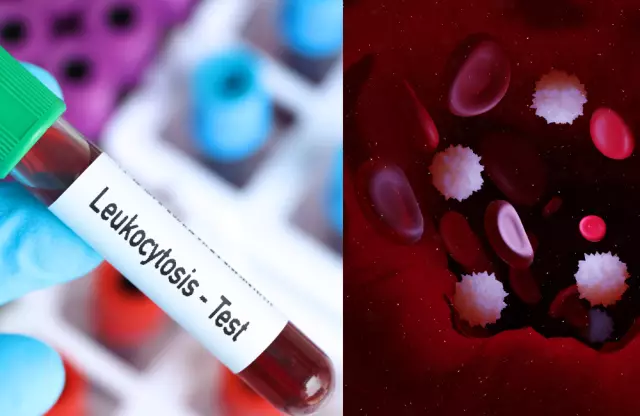- Author Rachel Wainwright [email protected].
- Public 2023-12-15 07:39.
- Last modified 2025-11-02 20:14.
Hepatitis
The statistics of the World Health Organization (WHO) indicate that more than 30% of the adult population of the Earth suffers from one or another liver disease. In Russia, such diseases claim the lives of about 400,000 people every year. At the same time, the number of deaths from hepatitis, cirrhosis and hepatosis is constantly growing.

In this article, we will talk about viral hepatitis, since it is they that pose the greatest danger to future generations of the inhabitants of our country. Viral hepatitis is the collective name for acute and chronic liver diseases. The causes of hepatitis are different, which determines their wide distribution and variety of forms. Regardless of the etiology, signs of hepatitis always indicate the development of an inflammatory process in the human liver. For this reason, the people often call the disease "jaundice" - by the most characteristic symptom of hepatitis of all types.
Classification of hepatitis
Hepatitis A is the most common and least dangerous viral hepatitis. The incubation period for infection is 7 days to 2 months. Infection occurs through the consumption of low-quality food. In addition, acute hepatitis A is transmitted through direct contact with the person's belongings and dirty hands. In most cases, the infection ends in spontaneous recovery, but sometimes patients are prescribed droppers, which reduce the intensity of the toxic effect on the liver.
Hepatitis B - transmitted through blood, during sexual intercourse, by injection with non-sterile syringes. This form is very dangerous, because it causes severe liver damage and is accompanied by severe symptoms: fever, enlarged liver and spleen, nausea, vomiting, severe joint pain. Hepatitis B requires complex treatment in a hospital setting with the obligatory use of immune drugs, hormones, antibiotics and hepatoprotectors.
Hepatitis C is one of the most severe forms of the disease, often leading to cirrhosis, liver cancer and, as a result, patient death. The most likely route of infection is through blood during transfusions, but hepatitis C can also be transmitted during sexual intercourse and from a sick mother to the fetus. The incidence in Russia and abroad is constantly growing, therefore, when diagnosed with hepatitis C, treatment and prevention involve an integrated approach to solving the problem, careful monitoring of the state of donated blood, and the spread of visual agitation among the population. The danger of this form lies in the fact that hepatitis C is often combined with other forms of viral hepatitis, and, in addition, there is currently no effective vaccine that would reliably protect a healthy person from infection.
Hepatitis D - was discovered and researched in 1977. Later, scientists proved that viral hepatitis "delta" is a type of hepatitis B, which results from the combination of the main strain of the virus and the delta agent.
Hepatitis E - the signs of infection are similar to the symptoms of hepatitis A, but with a severe course of the disease, not only the liver is damaged, but also the kidneys. The prognosis of treatment is almost always favorable. An exception is pregnant women in the third trimester, when the risk of losing a child approaches 100%. Prevention of hepatitis E is similar to that of hepatitis A.
Acute and chronic hepatitis
The acute form of the disease is the most typical for all viral hepatitis. Patients are noted: deterioration of health, severe intoxication of the body, impaired liver function, the development of jaundice, an increase in the amount of bilirubin and transaminase in the blood. With adequate and timely treatment, acute hepatitis ends with a complete recovery of the patient.
If the disease lasts more than 6 months, then the patient is diagnosed with chronic hepatitis. This form is accompanied by severe symptoms (asthenovegetative disorders, enlargement of the liver and spleen, metabolic disorders) and often leads to cirrhosis of the liver, the development of malignant tumors. Human life is under threat when chronic hepatitis, whose symptoms indicate damage to vital organs, is aggravated by improper treatment, reduced immunity, and alcohol dependence.
Signs of hepatitis and the clinical picture of infection
One of the most common symptoms of hepatitis is jaundice. It occurs when the bile produced by the liver enters the human bloodstream and spreads throughout the body, giving the skin a yellowish tint. Note also that some forms of the disease proceed without jaundice, so the most reliable way to diagnose the virus is a laboratory test for hepatitis.
Common symptoms of hepatitis:
- temperature rise;
- changes in skin pigmentation;
- headache;
- aching joints;
- general malaise;
- in some cases - the appearance of skin rashes;
- decreased appetite.
The intensity of the symptoms depends on the form of the infection. Hepatitis A is characterized by a rapid course, so the signs of hepatitis are pronounced and progress in just a few hours. Hepatitis B and hepatitis C develop gradually. At the initial stages, they can be limited to weakness and decreased appetite, and pain, nausea, vomiting, darkening of urine and other symptoms appear only after a few days. Note also that after the onset of jaundice, the patient's condition usually improves. An exception is hepatitis C, in which the process of liver tissue necrosis is most often chronic.
In some cases, patients develop so-called fulminant acute hepatitis. This is an extremely severe form of the disease in which there is massive tissue death and extremely rapid development of symptoms. If untreated, such acute hepatitis ends in death.
With chronicity, the signs of hepatitis change. The symptoms of the disease are variable, which is why many people do not pay enough attention to them. This is the wrong approach. A doctor should be consulted in all cases when there is reason to suspect chronic hepatitis. It is usually accompanied by:
- constant malaise and a feeling of weakness, which intensifies towards the end of the day;
- nausea, vomiting;
- joint and muscle pain;
- pain in the abdomen;
- darkening of urine;
- itchy skin;
- losing weight;
- bleeding.
The above symptoms are the undoubted reason for going to the clinic, where doctors should conduct an analysis for hepatitis, determine the exact cause of the unpleasant phenomena and prescribe adequate treatment.
Complications of hepatitis
Both acute and chronic hepatitis can lead to very serious consequences. Among them, it is worth noting:
- inflammatory diseases of the biliary tract;
- hepatic coma (ends in death in 90% of cases);
- cirrhosis of the liver - occurs in 20% of patients with viral hepatitis. The most common cause of cirrhosis is hepatitis B and its derivatives;
- liver cancer;
- dilation of blood vessels and subsequent internal bleeding;
- accumulation of fluid in the abdominal cavity - ascites.
The greatest number of severe complications is caused by hepatitis C in the chronic stage of development. The problem is aggravated by the lack of effective methods of treating this form, therefore, for any adverse symptoms, a person should definitely consult a doctor. It is not worth neglecting a visit to the clinic, because it is quite possible that the timely prescribed treatment will preserve not only the health, but also the life of the patient.
Hepatitis A, B, C - treatment and prognosis

Treatment of hepatitis A is based on basic therapy, adherence to bed rest and a strict diet. If indicated, patients are prescribed symptomatic and detoxification therapy (intravenous or oral). In most cases, viral hepatitis A can be cured without any problems and does not have serious complications.
A similar situation is observed in the case of the B-form of infection. With adequate treatment, hepatitis B results in a full recovery of the patient in 80% of cases. It is very important to prevent the transition of the disease to a chronic form, which is often accompanied by the development of cirrhosis. Patients are prescribed basic therapy, taking drugs that improve metabolic processes, if indicated, antiviral therapy (recombinant interferon alpha). Hepatitis B requires long-term treatment. In some situations, there is a need for repeated courses of therapy.
Hepatitis C often becomes chronic and causes the development of cirrhosis and liver cancer in every 7th patient. Accordingly, when diagnosed with hepatitis C, treatment has two important goals:
- reduce the intensity of inflammatory processes in the liver to reduce the risk of cirrhosis;
- eliminate the virus from the body (in whole or in part). The priority area again is working with the liver.
The main treatment method involves the use of interferon alpha. This drug prevents the appearance of new infected cells, but has side effects (fever, weakness, loss of appetite) that disappear 1.5-2 weeks after the start of the course. Note that interferon alpha does not guarantee complete elimination of hepatitis C, however, it reduces the risk of developing cirrhosis and improves the quality of life. To increase the positive effect, the drug is used in combination with ribavirin.
After the end of treatment, the patient must donate blood every month to timely detect signs of re-inflammation of the liver.
Prevention of hepatitis
To prevent acute or chronic hepatitis from becoming a reality for you, you must follow a number of simple rules:
- do not drink unboiled water;
- always wash fruits and vegetables;
- wash your hands before eating;
- do not share personal hygiene items with other people;
- just in case, regularly get tested for hepatitis for early detection of infection;
- refrain from piercings and tattoos;
- be careful when using syringes and needles (important for people who use drugs);
- choose your sexual partner carefully;
- get vaccinated on time.
YouTube video related to the article:
The information is generalized and provided for informational purposes only. At the first sign of illness, see your doctor. Self-medication is hazardous to health!






